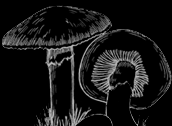UCSC Fungal Herbarium Sequencing Project
Background
 The UCSC Fungal Herbarium comprises thousands of specimens of mushrooms and other fungi collected primarily from coastal California, especially Santa Cruz County.
The UCSC Fungal Herbarium comprises thousands of specimens of mushrooms and other fungi collected primarily from coastal California, especially Santa Cruz County.
The large majority of these were collected and photographed by Noah Siegel or myself during our research expeditions in preparation for writing our upcoming field guide Mushrooms of the Redwood Coast. Other collections come from David Arora, Tonya Haff, members of the Fungus Federation, as well as the foray collections from the 1998 NAMA Foray held at Asilomar, and some from the 2012 NAMA Foray held in Scotts Valley.
The UCSC collection is special - it covers our county very thoroughly - more thoroughly than any other county in California to date. It is extremely well-photographed, meaning that we will not be left guessing at the 'face' of the organisms we are studying. Many of the collections are recent (and thus in very good shape), and thus are more likely to be available for researchers for decades to come. Microscopic data accompanies many of the collections, and many more of the specimens are being worked on by a small but dedicated body of undergraduate students, graduate researchers and community members doing thesis projects, ecology research or independent studies.
Sequencing Project
In 2013, I proposed a DNA sequencing initiative to the Ministers of the Fungus Federation of Santa Cruz. The idea was to select 500 high-priority specimens from the collection to sequence to obtain DNA sequences from. By doing so, we would end up with a relatively sizable, well-photographed, microscopically investigated, genetically characterized, and well-preserved cross-section of the mycoflora from our the county we call home.
After deliberation about the structure of the project and funding levels, the Fungus Federation approved the project and in March 2014 the first round of 25 'tester' specimens was sent to ALVA Labs for DNA extraction, amplification, and sequencing. Results came in the first week of April.
The first 25 specimens were selected a bit more loosely than the next 475 specimens will be chosen. Since these were intended to test the limits of the lab's sequencing abilities, they were chosen to represent a large phylogenetic range of fungi, while including a large number of non-critical 'padding' specimens in case the sequencing did not end up working. Of the 25 specimens we sent, four repeatedly resisted DNA extraction and/or sequencing efforts, one for obvious reasons; the other three are less clear.
Results from Round 1 (25 specimens)
- CSALVA-1: Cantharellus sp
- CSALVA-2: Pouzarella ferreri
- CSALVA-3: Ossicaulis sp
- CSALVA-4: Leptonia sp
- CSALVA-5: Leptonia sp
- CSALVA-6: Psathyrella uliginicola
- CSALVA-7: Leptonia sp
- CSALVA-8: Leptonia sp
- CSALVA-9: Leptonia cf. sodalis
- CSALVA-10: Leptonia ‘carrot stipe’
- CSALVA-11: Phaeomarasmius sp
- CSALVA-12: Leptonia ‘Shasta purple’
- CSALVA-13: Leptonia carnea
- CSALVA-14: Bolbitius sp
- CSALVA-15: Truncocolumella citrina
- CSALVA-16: Hebeloma cf mesophaeum
- CSALVA-17: Leptonia sp
- CSALVA-18: Naucoria bohemica
- CSALVA-19: Hypomyces lateritius
- CSALVA-20: Helvella cf. macropus
- CSALVA-21: Clitocybe salmonilamella
- CSALVA-22: Agrocybe cf. erebia
- CSALVA-23: Trametes hirsuta
- CSALVA-24: Clitopilus hobsonii
- CSALVA-25: Amanita ‘sandhill’
